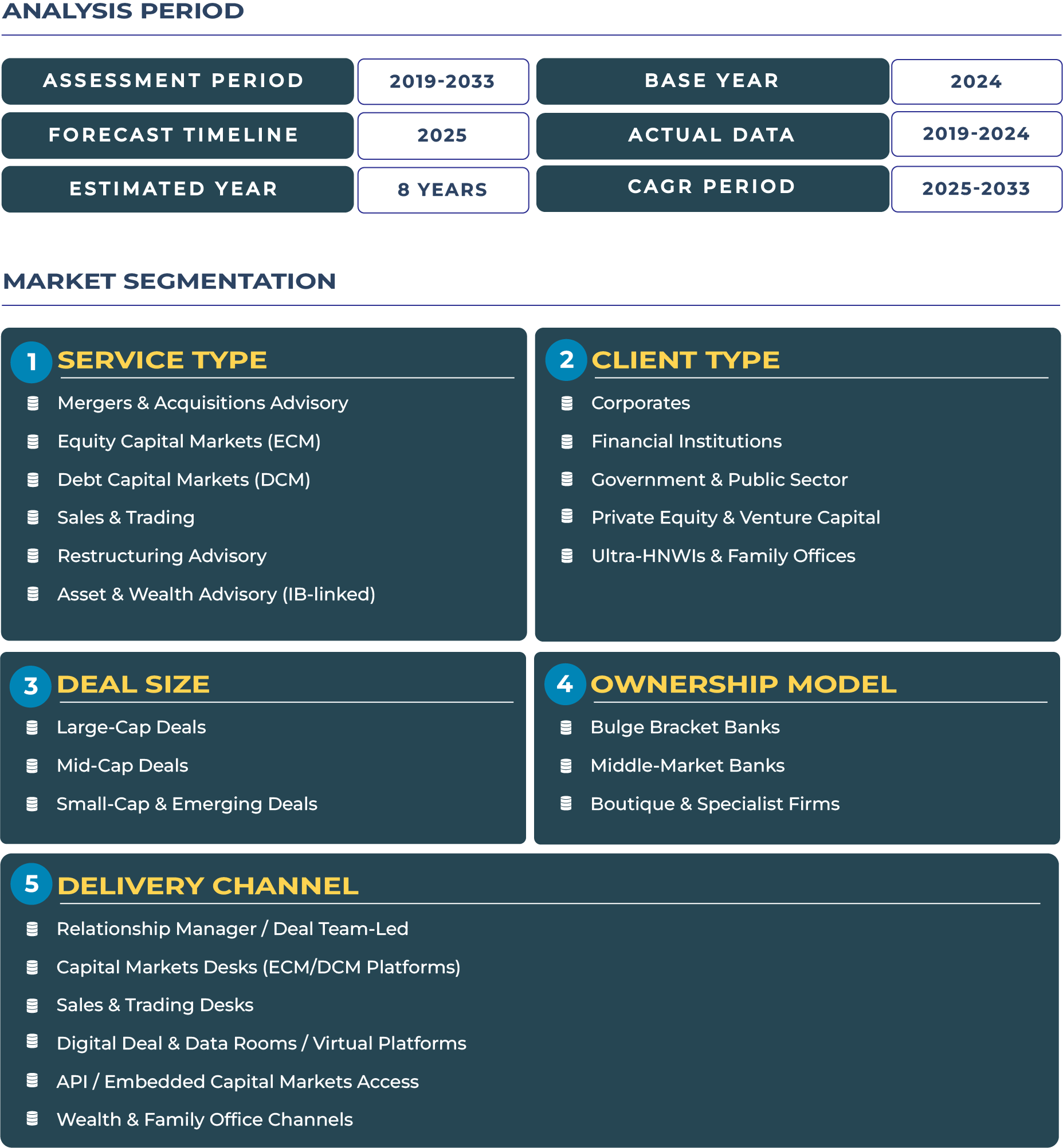Mexico Investment Banking Market Outlook: Empowering Infrastructure Growth and SME Capitalization in a Dynamic Economy
The Mexico Investment Banking Market stands at a transformative juncture as the nation experiences renewed emphasis on infrastructure financing, public-private partnerships (PPPs), and small and medium enterprise (SME) advisory services. With strategic reforms driving transparency, stronger capital inflows, and evolving financial ecosystems, Mexico is poised to redefine its position in North America investment banking landscape. The country’s robust participation in regional trade blocs, diversified economy, and focus on green infrastructure have elevated its appeal among international investors and advisory firms.
Note:* The market size refers to the total revenue generated by banks through interest income, non-interest income, and other ancillary sources.
According to DataCube Research, the Mexico Investment Banking Market is estimated at USD 7.8 billion in 2025 and is projected to reach USD 10.7 billion by 2033, reflecting a CAGR of 4.0% during the forecast period. This steady growth reflects Mexico’s deepening financial integration, accelerating infrastructure projects, and growing demand for corporate advisory in an increasingly complex economic environment.
Strengthening Mexico’s Financial Backbone Through PPPs and Mid-Market Advisory Excellence
Mexico investment banking sector is gaining momentum as the government continues to prioritize infrastructure modernization and SME development. The market is witnessing rising engagement from both domestic and global institutions in financing sectors such as energy, transportation, and digital infrastructure. Large-scale PPP initiatives are facilitating a new wave of project finance transactions, enabling investment banks to deliver long-term advisory and debt structuring services. The government’s commitment to modernization under the Secretaría de Infraestructura, Comunicaciones y Transportes has catalyzed multiple strategic projects in highways, airports, and railways.
Additionally, the rise of Mexico’s export-driven manufacturing ecosystem has expanded demand for corporate finance and restructuring advisory. Despite global volatility, local firms are seeking equity and debt solutions to support growth amid supply chain shifts driven by nearshoring trends. While inflation and monetary tightening present temporary challenges, Mexico’s stable banking foundation and proactive fiscal measures have preserved investor confidence. The result is an investment banking landscape that balances domestic opportunity with global connectivity, shaping Mexico into a financial hub for Latin America’s next wave of development.
Drivers & Restraints: Infrastructure and PPP Momentum Outweigh Political Uncertainties
Infrastructure Projects and PPPs as Catalysts of Market Expansion
The growth of infrastructure financing and PPPs is the central driver of Mexico investment banking industry. Strategic investment in logistics corridors, renewable energy projects, and urban transit has created diverse opportunities for debt capital market issuance and structured financing. Banks and investment firms are partnering with public authorities to develop sustainable projects with long-term economic impact. Additionally, the implementation of green bond frameworks has drawn international investors, expanding the country’s capital market depth and supporting advisory opportunities.
The SME sector also contributes significantly to this growth. Investment banks are increasingly offering mid-market merger and acquisition advisory and private placement solutions to help smaller enterprises access capital. As these businesses seek to professionalize operations, demand for asset and wealth advisory services tied to investment banking has risen. Collectively, these dynamics underscore a maturing ecosystem that blends large-scale public projects with grassroots financial inclusion.
Political and Currency Volatility Limiting Deal Flow Predictability
Despite strong growth drivers, the Mexican investment banking landscape faces notable constraints. Political uncertainty around upcoming elections and policy transitions occasionally dampens investor confidence, leading to cautious capital deployment. Exchange rate fluctuations and exposure to external shocks from the U.S. economy also create valuation risks in cross-border transactions. Regulatory complexities in capital markets and inconsistent project execution timelines have added friction to long-term deal pipelines.
Additionally, uneven enforcement of financial compliance standards has challenged smaller market participants, creating reliance on larger, better-capitalized investment banks. Nonetheless, efforts by the Secretaría de Hacienda y Crédito Público (SHCP) to stabilize fiscal frameworks and enhance transparency continue to mitigate these challenges, allowing the market to recover swiftly from cyclical disruptions.
Trends & Opportunities: Fintech Integration and SME Advisory Transforming Mexico Investment Banking Landscape
Fintech Adoption Accelerates Efficiency and Access in Investment Banking
One of the most transformative trends in the Mexico investment banking sector is the rapid integration of fintech solutions into corporate and institutional finance. Investment banks are collaborating with financial technology providers to streamline advisory workflows, automate credit assessment, and digitize securities trading. The adoption of open banking standards and real-time payments, championed by Mexico’s central bank Banco de México, is fostering innovation and inclusion within capital markets. This digital convergence is expected to improve transaction transparency, enhance compliance monitoring, and accelerate deal execution timelines across both ECM and DCM segments.
SME Financing and Regional Advisory Offer New Growth Horizons
Mexico’s SME segment represents an untapped frontier for investment banks. With SMEs accounting for over 90% of enterprises, tailored advisory and structured financing products have become a major growth opportunity. Regional investment banks are developing hybrid advisory-financing models to facilitate business expansion, particularly in manufacturing, logistics, and renewable energy. Furthermore, the increasing emphasis on ESG standards and sustainable lending practices opens new pathways for impact-focused investment banking across regional and mid-tier companies.
Urban financial centers like Mexico City and Monterrey are evolving into regional advisory hubs for American corporate clients seeking capital market access. This deepens Mexico’s role as both a domestic and cross-border investment banking bridge for the Americas.
Competitive Landscape: Expanding SME Advisory and Embedded Finance Strategies Redefine Competition
The competitive structure of the Mexico investment banking market is characterized by a mix of established domestic players and global financial institutions. Leading local firms such as Banorte and BBVA México are strengthening SME-focused advisory networks to capture emerging market opportunities. Meanwhile, international banks are investing in local partnerships to expand merger and acquisition and structured finance capabilities.







